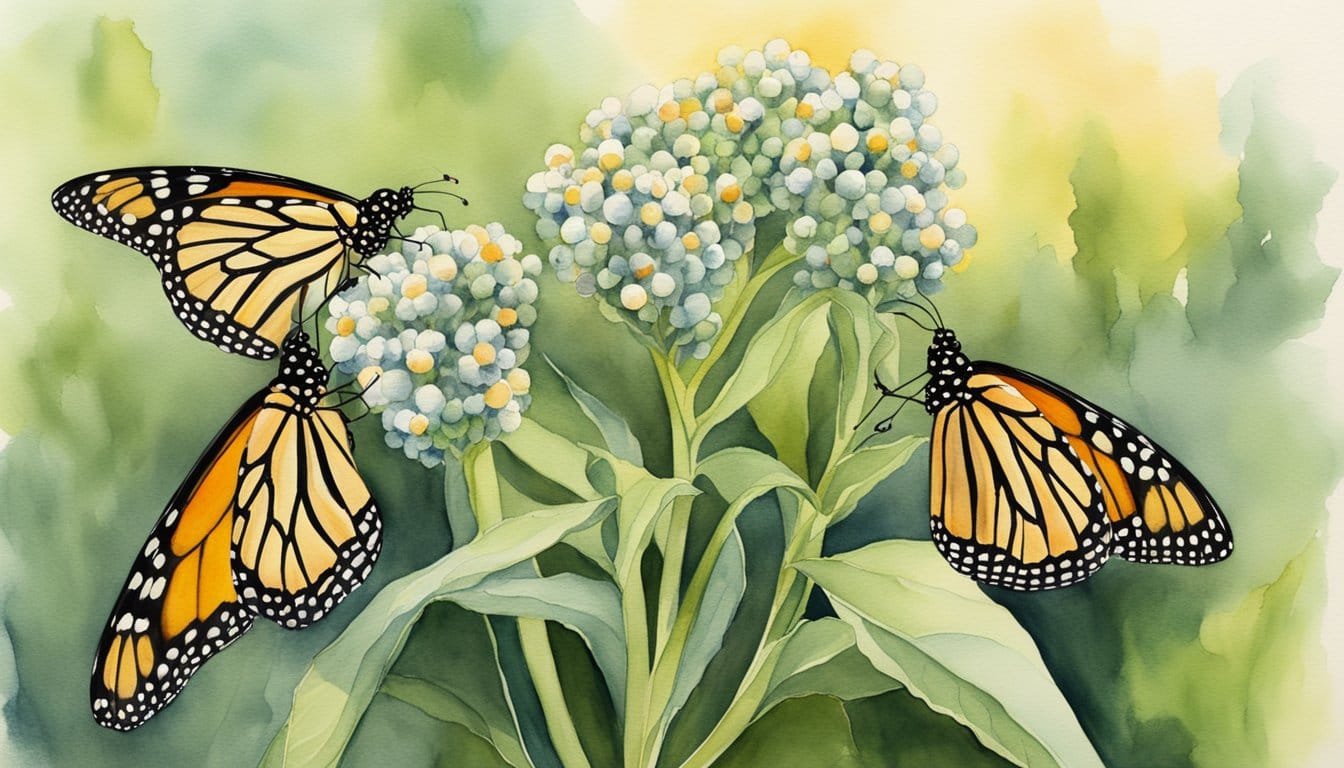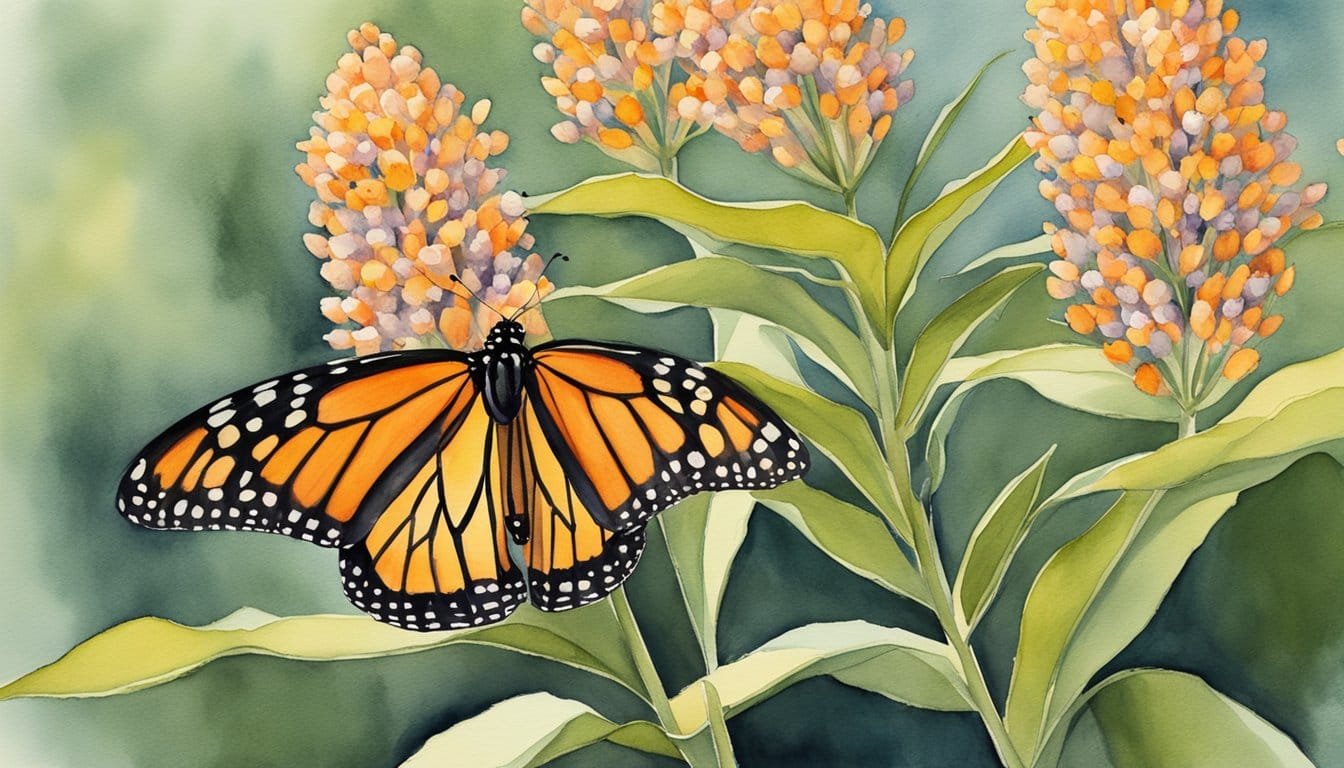Monarch Butterfly Toxicity
The Monarch butterfly (Danaus plexippus) has a unique chemical defense mechanism that protects it against predators. By consuming toxic milkweed plants during its larval stage, it retains potent cardenolides in its system, making it poisonous to potential threats.
Chemical Defense Mechanism
As caterpillars, Monarch butterflies ingest toxic compounds from milkweed plants, which contain cardiac glycosides. These substances are stored within the butterfly’s tissues as they metamorphose from larvae through to the chrysalis stage and into adulthood. The accumulation of toxins, primarily cardenolides, is a strategic adaptation for survival; it deters predation by causing adverse effects in birds and other animals that might consider Monarch butterflies a meal.
- Milkweed consumption: Caterpillars exclusively feed on milkweed, which is toxic to most vertebrates.
- Toxin Retention: The toxins are carried through to the adult butterfly stage.
Effects on Predators and Human Interaction
Animals, specifically birds, that prey on Monarch butterflies can experience heart poisons due to the cardenolides, leading to vomiting or avoidance of the brightly colored insects altogether. This toxicity, a product of the butterfly’s diet on milkweed plants, thus serves as a defense system ensuring the Monarch’s survival. While monarchs are poisonous to their predators, they are generally not harmful to humans. However, it is not advisable for people to consume Monarch butterflies or milkweed, as these cardiac glycosides can have toxic effects.
- Bird Detriment: Predatory birds may suffer heart complications if they consume Monarch butterflies.
- Human caution: Though not a typical food item for humans, caution is still advised when handling milkweed or Monarchs due to their poisonous nature.
Life Cycle and Migration

Monarch butterflies undergo a captivating transformation during their life cycle, punctuated by a dramatic migration that has caught human admiration for generations. These colorful insects are not only a wonder to behold but also play a pivotal role in our ecosystems.
Stages of Development
The monarch butterfly’s life begins as an egg laid on the underside of milkweed leaves. After hatching, the caterpillar emerges, feasting on the toxic milkweed which imparts the monarch’s iconic defense, making them distasteful to predators. The next transformative stage is the chrysalis, where the caterpillar undergoes metamorphosis. Finally, the adult butterfly emerges, completing the cycle.
Migration Patterns
Twice a year, monarchs embark on a staggering journey spanning thousands of miles. The eastern population flies up to 3,000 miles from the Northeastern United States and Canada to the overwintering sites in central Mexico. Conversely, the western population typically travels shorter distances to coastal California. These migrations are multigenerational, meaning no single butterfly completes the round trip.
Environmental Challenges
Monarch butterflies face numerous environmental challenges that threaten their migration and survival. Habitat loss and climate change directly impact their breeding grounds and overwintering sites. In the United States, conservation efforts are in motion, with the Monarch butterfly being considered for protection under the Endangered Species Act. Protecting the vital milkweed plant and mitigating climate change effects are crucial to prevent further decline.
Discover more about monarch migration Fueling the fall migration of the monarch butterfly
Read on the impacts of neonicotinoids Host plant species mediates impact of neonicotinoid exposure to monarch butterflies
Investigate the ecology of monarch infection during migration Multi-trophic interactions and migration behaviour determine the ecology and evolution of parasite infection in monarch butterflies
Learn about the effects of pesticides on migration orientation Effects of early-life exposure to sublethal levels of a common neonicotinoid insecticide on the orientation and migration of monarch butterflies
Monarch Butterfly Characteristics

Monarchs are flying wonders known for their striking orange, white, and black patterns. These butterflies are not just beautiful; they carry surprising secrets in their delicate wings.
Physical Features
The monarch butterfly, or Danaus plexippus, boasts an unmistakable canvas of orange, white, and black across its wings. These colors serve as a warning, as monarchs are known to be distasteful to predators due to toxins accumulated from their diet. The average wingspan of these insects stretches between 3.7 to 4.1 inches, and they flutter delicately through the air, weighing only about 0.0095 to 0.026 ounces.
| Color | Wingspan | Weight |
|---|---|---|
| Orange, White, Black | 3.7 to 4.1 inches | 0.0095 to 0.026 ounces |
Behavior and Diet
Monarch butterflies have a fascinating life cycle that involves a milkweed-centric diet in their larval stage, which contributes to their toxicity. As adults, they diversify and sip nectar from a variety of flowers, acting as pollinators in the ecosystem. When it comes to breeding, monarchs are not particularly choosy; they will mate with multiple partners, ensuring the continuation of their species. Another peculiar behavior is their migration, which can span thousands of miles, driven by an innate navigation system that leads them to specific overwintering sites. During these flights, they may be seen congregating in large numbers to rest, where they are known to enjoy sipping on sodium-rich substances that help maintain their sodium pump physiology.

